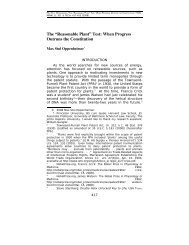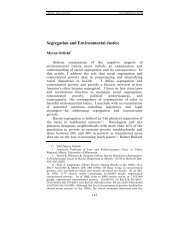An Organizational Approach to the Design of Patent Law
An Organizational Approach to the Design of Patent Law
An Organizational Approach to the Design of Patent Law
You also want an ePaper? Increase the reach of your titles
YUMPU automatically turns print PDFs into web optimized ePapers that Google loves.
6 VERTINSKY FINAL_JAD (DO NOT DELETE) 2/27/2012 2:20 PM<br />
2012] AN ORGANIZATIONAL APPROACH 277<br />
economy <strong>of</strong> <strong>the</strong> future,” and updated it in February 2011 <strong>to</strong><br />
build on key aspects <strong>of</strong> <strong>the</strong> strategy. 277 The policy calls for<br />
streng<strong>the</strong>ning competitive markets through regula<strong>to</strong>ry reform<br />
and a rethinking <strong>of</strong> <strong>the</strong> relationship between public and private<br />
sec<strong>to</strong>rs, for government intervention in key sec<strong>to</strong>rs where<br />
“markets may fail on <strong>the</strong>ir own,” and for increased investment<br />
in <strong>the</strong> basic infrastructure underlying systems <strong>of</strong> innovation. 278<br />
A key <strong>the</strong>me in <strong>the</strong> national innovation policy is <strong>the</strong> importance<br />
<strong>of</strong> collaboration and <strong>the</strong> need <strong>to</strong> foster new and improved regional<br />
and local systems <strong>of</strong> innovation. 279 The America<br />
COMPETES Act, passed in 2007 and reauthorized in 2011,<br />
emphasizes <strong>the</strong> use <strong>of</strong> organizational strategies <strong>to</strong> support innovation.<br />
These strategies include fostering new kinds <strong>of</strong> collaboration,<br />
particularly public-private collaborations such as<br />
those between universities, government labs, and firms, and<br />
supporting new forms <strong>of</strong> economic organization, such as <strong>the</strong><br />
creation <strong>of</strong> regional innovation clusters. 280 Although <strong>the</strong> patent<br />
system was created for <strong>the</strong> purpose <strong>of</strong> encouraging innovation,<br />
patent policy is marginalized in current national innovation<br />
strategies. This paper provides a way <strong>of</strong> answering this puzzle<br />
and, more importantly, a way <strong>of</strong> making patent policy more relevant<br />
<strong>to</strong> innovation policy. I have argued that <strong>the</strong> neglect <strong>of</strong> patents<br />
as important <strong>to</strong>ols in fur<strong>the</strong>ring <strong>the</strong> goals <strong>of</strong> national innovation<br />
strategies can be explained at least in part by <strong>the</strong><br />
focus <strong>of</strong> traditional approaches <strong>to</strong> patent policy on incentives <strong>to</strong><br />
invent ra<strong>the</strong>r than efforts <strong>to</strong> support innovation systems.<br />
277. NAT’L ECON. COUNCIL, supra note 3, at i; see also A Strategy for American<br />
Innovation: Securing Our Growth and Prosperity, WHITE HOUSE (Feb.<br />
2011), http://www.whitehouse.gov/innovation/strategy.<br />
278. NAT’L ECON. COUNCIL, supra note 2, at ii (introducing a national innovation<br />
strategy built around government investment in key areas <strong>of</strong> innovation<br />
and in <strong>the</strong> infrastructure and o<strong>the</strong>r “inputs” <strong>of</strong> innovation and promotion<br />
<strong>of</strong> competitive markets <strong>to</strong> produce <strong>the</strong> innovations needed, and advocating for<br />
government intervention <strong>to</strong> support market production).<br />
279. Id. at 19.<br />
280. America COMPETES Reauthorization Act <strong>of</strong> 2010, H.R. 5116, 111th<br />
Cong. (2010) (investing in innovation through R&D and improving American<br />
competitiveness); see, e.g. Robert D. Atkinson, Eight Ideas for Improving <strong>the</strong><br />
America COMPETES Act, INFO. TECH. & INNOVATION FOUND., March 2010, at<br />
1, available at http://www.itif.org/files/2010-america-competes.pdf; Fred Block<br />
& Mat<strong>the</strong>w R. Keller, Where Do Innovations come From? Transformations in<br />
<strong>the</strong> U.S. National Innovation System, 1970-2006, INFO. TECH. & INNOVATION<br />
FOUND., July 2008, at 1, available at http://www.itif.org/files/<br />
Where_do_innovations_come_from.pdf (documenting <strong>the</strong> importance <strong>of</strong> collaborations<br />
between universities, federal labs, small firms, and large firms as<br />
drivers <strong>of</strong> innovation).






